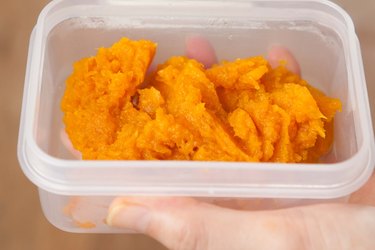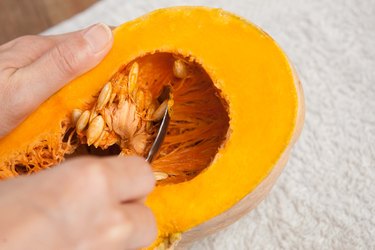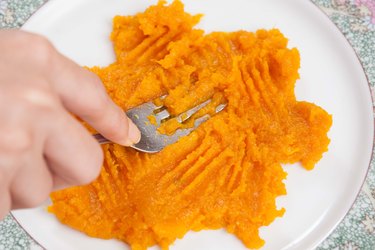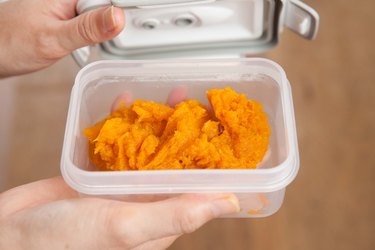
Golden pumpkins in the fields and golden-brown pumpkin pies on the table are as sure-fire a sign of autumn as the flame-colored leaves. Often those pumpkin pies are made from canned puree, for the sake of convenience, but if you have access to fresh pumpkins, you can make your own puree. It's generally a bit paler in color but has a fresher taste, and it gives your holiday feast an unmistakably homemade touch.
Picking Your Pumpkin
Video of the Day

If you've made your own puree in the past and been disappointed with it, it's likely you've simply chosen the wrong pumpkin. Large, decorative jack-o'-lantern pumpkins are relatively bland and watery when cooked. With their denser, sweeter flesh, smaller pie pumpkins or sugar pumpkins are best. You can also use your favorite squash, if you prefer, which provides a dense and sweet finished product. Squashes and pumpkins come from the same handful of species, and their conventional names have more to do with tradition than science. In fact, canned pumpkin is usually made from squash. Whichever you choose, the cooking and pureeing process is much the same.
Video of the Day
Preparing and Cooking

Start by halving the pumpkin and scooping out its seeds. They can be saved and roasted for a tasty snack, if you wish. For a deeply flavored puree to use in pumpkin pies or cheesecakes, it's best to roast the pumpkin -- in halves, if small, or cut-up pieces if large -- on a baking sheet at 350 degrees Fahrenheit until it's tender. The oven's dry heat concentrates and caramelizes the pumpkin's sugars, enhancing its flavor. For a milder-tasting puree to use in breads, scones or other dishes, boil or steam the pumpkins in a large pot until tender. Small quantities can also be cooked in the microwave for 10 to 15 minutes, or until tender.
Making Your Puree

Once the pumpkin is cool enough to handle, scoop it from the rind, mash it to a pulp, or puree it with a food processor or blender. If the flesh is noticeably wet, transfer it to a colander and place a plate over its top with a large can to provide weight. This will press out any excess moisture, which can be saved for cooking or baking. For jack-o'-lantern pumpkins and other wet, mild-flavored varieties, you can create a drier and more flavorful puree by gently cooking the mashed flesh in a Dutch oven, slow-cooker or roasting pan until the excess moisture evaporates, and the flesh is slightly caramelized and browned. Stir frequently to keep it from sticking and scorching.
Storage Options

The puree is ready to use as soon as it's finished, but a good-sized pumpkin is likely to produce more than you can use at one time. The remainder can be divided into recipe-sized portions and sealed in airtight containers, for refrigeration or freezing. If properly packaged, the puree will freeze for up to a year with no appreciable loss of quality, ready to be thawed when you feel the urge for a pie or batch of richly flavored scones. Pumpkin puree cannot be safely canned at home, so that preservation method is not recommended.
- King Arthur Flour: Baking With Pumpkin? Making Your Own Fresh Pumpkin Puree Is Easy
- The Kitchn: Canned Pumpkin -- What Is It Really Made of?
- University of Illinois Extension: Pumpkins and More -- Selection and Use
- University of Illnois Extension: Pumpkin -- All America Selections
- University of Illinois Extension: Pumpkin Facts